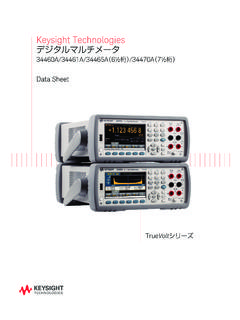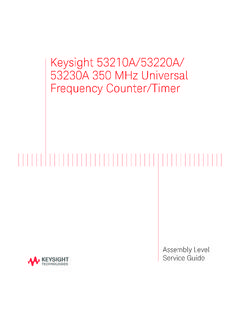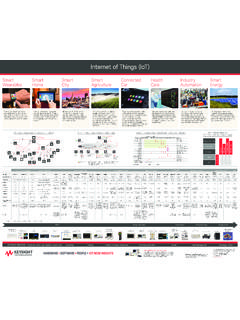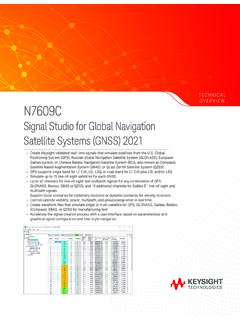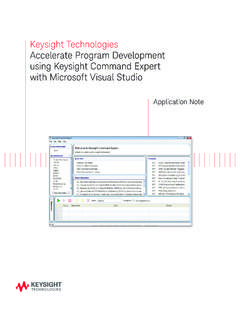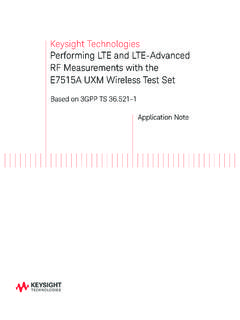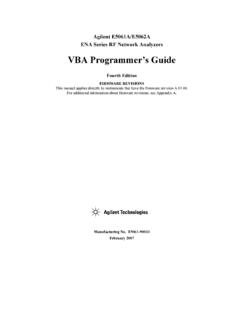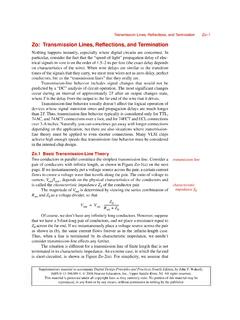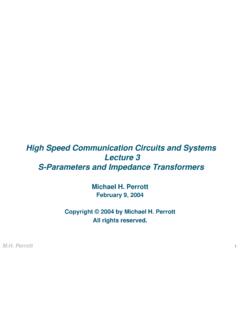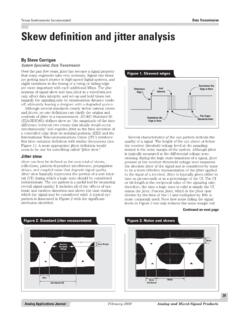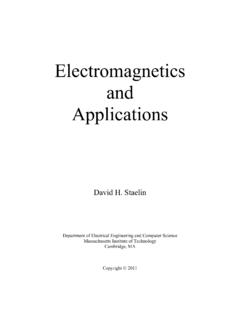Transcription of S-Parameter
1 Page Find us at Page 1 S-Parameter Measurements Basics for High Speed Digital Engineers Frequency dependent effects are becoming more prominent with the increasing data rates of digital systems. Differential circuit topology is commonly-used as an implementation method, with the goal of enhancing the data carrying capable of the physical layer. Simple impedance and delay measurements of copper transmission lines are not sufficient to ensure accurate analysis of gigabit interconnects. The challenge to push design rules to the limit, now requires the use of concurrent time and frequency domain measurements.
2 The vector network analyzer (VNA) has traditionally been used by microwave engineers to design antennas and test microwave components. Today, a whole new generation of digital design engineers have learned to use the VNA to gain valuable insight into the performance of high speed digital interconnect such as backplanes, printed circuit boards, cables, connectors and even IC packages. These interconnect devices under test are linear and passive, so linear superposition holds, and differential S-parameters can be measured easily and accurately. Furthermore, the superior dynamic range of the VNA enables much higher precision when characterizing low level signals such as crosstalk.
3 Importantly, the advanced error correction capabilities of the VNA can move the reference plane closer to the device under test and remove the effects of lossy test fixtures. This results in better designed channels that transmit much higher data rates with very few errors at the receiver. This white paper will create a strong foundation of test and measurement science related to S-Parameter measurements and analysis. Signal integrity engineers who are just beginning their journey into high speed design will undoubtedly learn new concepts that can enable them to be more successful in the lab making measurements and, in the office, doing analysis.
4 More experienced signal integrity engineers will recognize many of the concepts and most likely pick up a few more clever tips and tools to make life easier during their workday. S-Parameter measurements are required in high-speed digital industry Page Find us at Page 2 Table of Contents Why Use S-Parameters? .. 3 Digital signal Transitions in Channels .. 4 Digital signals vs. Analog signals .. 5 Transfer function of sine waves What is the output? .. 6 What are S-parameters? .. 7 What are S-parameters? - Expressions .. 8 What are S-parameters? Lightwave Analogy .. 9 Mode conversion on a differential pair.
5 10 Balanced devices .. 11 4-port Differential S-parameters .. 12 S-Parameter measurements basics Vector Network Analyzer (VNA) .. 13 Frequency domain Time domain .. 14 S-Parameter & TDR/TDT measurements .. 15 Time domain Frequency domain .. 16 TDR (Sampling) scopes .. 17 VNA vs. TDR Scopes Advantage of VNA .. 18 Importance of calibration With or without the cal.. 19 Importance of calibration Error types .. 20 Importance of calibration Systematic error .. 21 Importance of calibration Calibration kits .. 22 How do we use S-parameters? On scopes .. 23 How do we use S-parameters? With simulation SW.
6 24 Why use S-parameters? .. 25 Summary .. 26 Keysight High-Speed Digital & Signal Integrity Solutions .. 27 Who Uses Time Domain Reflectometry? .. 28 What is PNA/ENA Option TDR? .. 28 ENA Option TDR Compliance Test Solution .. 29 Additional Resources .. 35 Page Find us at Page 3 Why Use S-Parameters? This is a sample of a typical transmitter device consisting of a chip, a package, and a card. A channel (transmission lines/traces) must match the characteristic impedance for a controlled impedance environment within the channel (50 as shown in the top-right figure). However, the output signal/waveform at the output connector (bottom-right eye diagram) is degraded/distorted compared to the input signal/waveform (top-left eye diagram).
7 Why is the waveform at the connector output degraded? Is it not enough measuring the characteristic impedance? Transmission line matches the characteristics impedance (50 ). Why is the waveform @ Connector output degraded? Is it not enough measuring the characteristics impedance? Page Find us at Page 4 Digital signal Transitions in Channels Fast edges of digital signal transitions from logic level zero to logic level one become degraded into slow edges as they transmit through the copper channel. Needs analog signal handling on high speed digital signals Test point 1 (TP1) Test point 2 (TP2) Comparing waveforms before and after transmitting the channel for 1 Gbps and 10 Gbps, the 10 Gbps waveform is dramatically distorted.
8 It s far from an ideal digital signal. The higher the bitrate, the more we need to observe/manage the digital signal same as an analog signal. Page Find us at Page 5 Digital signals vs. Analog signals 100 MHz square wave Let s see 100 MHz square wave for instance. With digital interpretation, it s a 200 Mbps bit pattern. On the other hand, with analog interpretation, it s a composite(synthesized) waveform consisting of sine waves, 100 MHz fundamental and harmonics. Digital Signals = Analog Signals (consists of sine waves) Digital interpretation 200 Mbps bit pattern Analog interpretation 100 MHz square wave which consists of sine waves Page Find us at Page 6 Transfer function of sine waves What is the output?
9 Devices that behave linearly only impose magnitude and phase changes on input signals. Any sinusoid appearing at the input will also appear at the output at the same frequency. No new signals are created. This is an example of a sine wave applied to a linear device which has the Output/Input and Phase characteristics shown below. The device imposes a non-uniform amplitude and phase change to each frequency component. At the frequency point 1, we can see the output signal same as the input signal (dotted line in the bottom-left figure). At 2, amplitude is decreased as half and phase is delayed as -90 degree (solid line in the bottom-left figure).
10 At 3, no signal can be detected from output. When a single sinusoid is passed through a linear network, amplitude and phase changes are not to be considered as distortion. However, when a complex time-varying signal is passed through a linear network, the amplitude and phase shifts can dramatically distort the time-domain waveform. Therefore both amplitude and phase information in frequency domain are important. Then, S-parameters are the parameter which supports both information and has many advantages for high frequency device characterization. Linear device = Output freq. equals to Input freq. Signal amplitude/phase are changed depending on frequency: Information on amplitude and/or phase characteristics in frequency domain S-parameters ?


